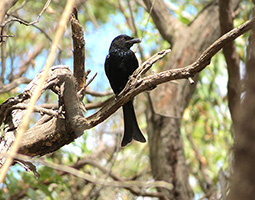Dicrurus bracteatus
Description

The Spangled Drongo, found throughout northern and eastern Australia, is the only species of drongo in Australia. It is easily recognised by its black, iridescent plumage with blue and purple highlights (spangles), crimson eyes and characteristic forked tail. Male and female are similar in appearance, but the females are slightly smaller in size.
The Spangled Drongo is noisy and conspicuous, using a variety of complex calls like sharp chatter and harsh rasping, but is also a mimic of the sounds it hears.
Spangled Drongos prefer wet forests, but can also be found in other woodlands, mangroves and parks. They tend to avoid more dense forest types and rainforest interiors. Birds are more common in the north, and are often seen either singly or in pairs. It is a migratory species, moving southwards in late spring and returning north in early autumn. It breeds high in an isolated tree, producing three to five young each year. Nests are cup-shaped in open spaces, where it is difficult for predators to access without being seen. Both adults are involved in nest-building, incubating and feeding the young.
Adaptations
- After catching an insect in the air in its slightly hooked bill, the prey is guided into the bill with the assistance of sensitive, long, wire-like bristles bordering the bill (rictal bristles)
- Some species are accomplished mimics and have a variety of alarm calls, to which other birds and animals often respond. There is evidence that they utter hoax alarm calls that typically scare other animals off food, which the drongo then eats.
Feeding relationships
- What I eat: insects and small vertebrates (e.g. birds, lizards); fruit and nectar
- What eats me: Raptors, Owls, Foxes, Pythons
Interesting Fact
The unsuccessful racehorse Drongo was named after the bird and led to the Australian slang insult "drongo" meaning "idiot".
Acknowledgements: Birds in Backyards, Australian Museum, Wikipedia